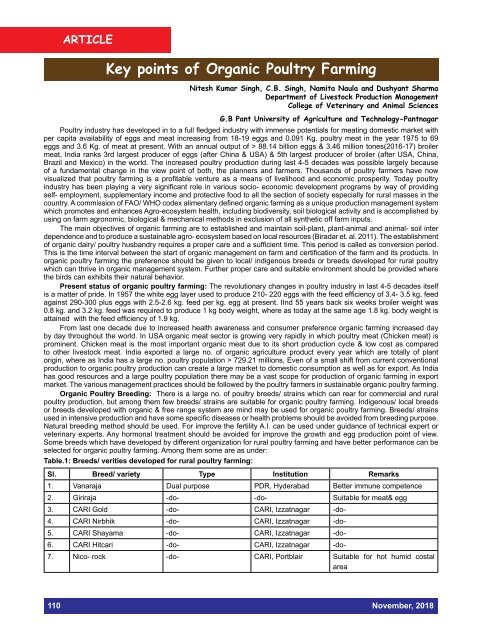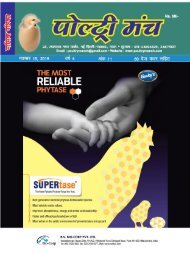November 2018 Punch PDF
Create successful ePaper yourself
Turn your PDF publications into a flip-book with our unique Google optimized e-Paper software.
ARTICLE<br />
Key points of Organic Poultry Farming<br />
Nitesh Kumar Singh, C.B. Singh, Namita Naula and Dushyant Sharma<br />
Department of Livestock Production Management<br />
College of Veterinary and Animal Sciences<br />
G.B Pant University of Agriculture and Technology-Pantnagar<br />
Poultry industry has developed in to a full fledged industry with immense potentials for meating domestic market with<br />
per capita availability of eggs and meat increasing from 18-19 eggs and 0.091 Kg. poultry meat in the year 1975 to 69<br />
eggs and 3.6 Kg. of meat at present. With an annual output of > 88.14 billion eggs & 3.46 million tones(2016-17) broiler<br />
meat, India ranks 3rd largest producer of eggs (after China & USA) & 5th largest producer of broiler (after USA, China,<br />
Brazil and Mexico) in the world. The increased poultry production during last 4-5 decades was possible largely because<br />
of a fundamental change in the view point of both, the planners and farmers. Thousands of poultry farmers have now<br />
visualized that poultry farming is a profitable venture as a means of livelihood and economic prosperity. Today poultry<br />
industry has been playing a very significant role in various socio- economic development programs by way of providing<br />
self- employment, supplementary income and protective food to all the section of society especially for rural masses in the<br />
country. A commission of FAO/ WHO codex alimentary defined organic farming as a unique production management system<br />
which promotes and enhances Agro-ecosystem health, including biodiversity, soil biological activity and is accomplished by<br />
using on farm agronomic, biological & mechanical methods in exclusion of all synthetic off farm inputs.<br />
The main objectives of organic farming are to established and maintain soil-plant, plant-animal and animal- soil inter<br />
dependence and to produce a sustainable agro- ecosystem based on local resources (Biradar et. al. 2011). The establishment<br />
of organic dairy/ poultry husbandry requires a proper care and a sufficient time. This period is called as conversion period.<br />
This is the time interval between the start of organic management on farm and certification of the farm and its products. In<br />
organic poultry farming the preference should be given to local/ indigenous breeds or breeds developed for rural poultry<br />
which can thrive in organic management system. Further proper care and suitable environment should be provided where<br />
the birds can exhibits their natural behavior.<br />
Present status of organic poultry farming: The revolutionary changes in poultry industry in last 4-5 decades itself<br />
is a matter of pride. In 1957 the white egg layer used to produce 210- 220 eggs with the feed efficiency of 3.4- 3.5 kg. feed<br />
against 290-300 plus eggs with 2.5-2.6 kg. feed per kg. egg at present. IInd 55 years back six weeks broiler weight was<br />
0.8 kg. and 3.2 kg. feed was required to produce 1 kg body weight, where as today at the same age 1.8 kg. body weight is<br />
attained with the feed efficiency of 1.9 kg.<br />
From last one decade due to increased health awareness and consumer preference organic farming increased day<br />
by day throughout the world. In USA organic meat sector is growing very rapidly in which poultry meat (Chicken meat) is<br />
prominent. Chicken meat is the most important organic meat due to its short production cycle & low cost as compared<br />
to other livestock meat. India exported a large no. of organic agriculture product every year which are totally of plant<br />
origin, where as India has a large no. poultry population > 729.21 millions, Even of a small shift from current conventional<br />
production to organic poultry production can create a large market to domestic consumption as well as for export. As India<br />
has good resources and a large poultry population there may be a vast scope for production of organic farming in export<br />
market. The various management practices should be followed by the poultry farmers in sustainable organic poultry farming.<br />
Organic Poultry Breeding: There is a large no. of poultry breeds/ strains which can rear for commercial and rural<br />
poultry production, but among them few breeds/ strains are suitable for organic poultry farming. Indigenous/ local breeds<br />
or breeds developed with organic & free range system are mind may be used for organic poultry farming. Breeds/ strains<br />
used in intensive production and have some specific diseases or health problems should be avoided from breeding purpose.<br />
Natural breeding method should be used. For improve the fertility A.I. can be used under guidance of technical expert or<br />
veterinary experts. Any hormonal treatment should be avoided for improve the growth and egg production point of view.<br />
Some breeds which have developed by different organization for rural poultry farming and have better performance can be<br />
selected for organic poultry farming. Among them some are as under:<br />
Table.1: Breeds/ verities developed for rural poultry farming:<br />
Sl. Breed/ variety Type Institution Remarks<br />
1. Vanaraja Dual purpose PDR, Hyderabad Better immune competence<br />
2. Giriraja -do- -do- Suitable for meat& egg<br />
3. CARI Gold -do- CARI, Izzatnagar -do-<br />
4. CARI Nirbhik -do- CARI, Izzatnagar -do-<br />
5. CARI Shayama -do- CARI, Izzatnagar -do-<br />
6. CARI Hitcari -do- CARI, Izzatnagar -do-<br />
7. Nico- rock -do- CARI, Portblair Suitable for hot humid costal<br />
area<br />
110 <strong>November</strong>, <strong>2018</strong>





